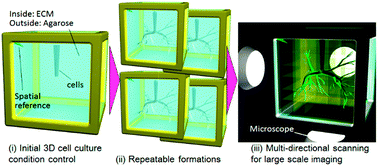High repeatability from 3D experimental platform for quantitative analysis of cellular branch pattern formations
Abstract
Three-dimensional (3D) cell and tissue cultures more closely mimic biological environments than two-dimensional (2D) cultures and are therefore highly desirable in culture experiments. However, 3D cultures often fail to yield repeatable experimental results because of variation in the initial culture conditions, such as cell density and distribution in the extracellular matrix, and therefore reducing such variation is a paramount concern. Here, we present a 3D culture platform that demonstrates highly repeatable experimental results, obtained by controlling the initial cell cluster shape in the gel cube culture device. A micro-mould with the desired shape was fabricated by photolithography or machining, creating a 3D pocket in the extracellular matrix contained in the device. Highly concentrated human bronchial epithelial cells were then injected in the pocket so that the cell cluster shape matched the fabricated mould shape. Subsequently, the cubic device supplied multi-directional scanning, enabling high-resolution capture of the whole tissue structure with only a low-magnification lens. The proposed device significantly improved the repeatability of the developed branch pattern, and multi-directional scanning enabled quantitative analysis of the developed branch pattern formations. A mathematical simulation was also conducted to reveal the mechanisms of branch pattern formation. The proposed platform offers the potential to accelerate any research field that conducts 3D culture experiments, including tissue regeneration and drug development.



 Please wait while we load your content...
Please wait while we load your content...